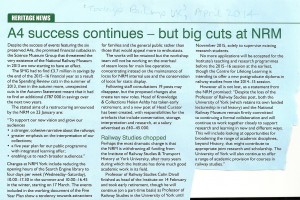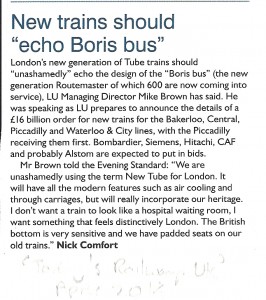Keeping the Show on the Road
The Management Committee met on April 10, once again at Cowley House, Oxford.The committee was pleased to note that Pat Campany had assumed responsibility as Membership Secretary, relieving John Ashley of one of his many tasks, but with regret learnt that Tony Newman, having resigned as a director, had also resigned as a member of the Committee. They were pleased to note, however, that he would remain Research Co-ordinator. Royston Fisher had also agreed to remain Treasurer whilst the quest continued for his replacement. The Committee, welcoming the news that Professor Mike Phillips, Pro Vice Chancellor, University of Wales, Trinity St David, had agreed to serve as a Director, extended an invitation to him to join the Committee. Subject to the advice of John Howie, as Company Secretary, it was recommended for the next AGM’s consideration that no more than three directors be appointed and that the directors be requested to give strategic direction to the Committee from time to time by formaldirection. The committee noted that the arrangements for the AGM and Conference in Coventry had run smoothly and that the three presentations had been very well received by those present. The AGM had been advised that the membership would be consulted on draft proposals for the development of the Association.
Wales on Wheels
It was confirmed that the ‘Wales on Wheels’ event, which was to be repeated on May 17, 2014 in Swansea, in collaboration with FirstGroup and the Swansea Bus Museum, was being actively promoted by the City of Swansea and promised to be more extensive than last year. Readers are urged to view the web site! The Swansea Bus Museum would be celebrating the hundred year anniversary of South Wales Transport with the publication of a book and special events. A reception would take place at the Waterfront Museum followed by a Dinner at the Marriott Hotel on Friday, May 16, at which Professor Stuart Cole was to speak. The Swansea Bus Museum would be continuing their celebratory programme on the Sunday [May 18].
The Great Book
As for the ‘Companion’, Martin Higginson reported that sales were proceeding satisfactorily and the committee repeated its appreciation of the patience and industry that had been exercised, in particular, by Martin Higginson, Simon Blainey and Ken Swallow, but also by the Editorial Board generally and their many collaborators, in bringing this major aid to scholarship to completion. The launch, on April 2 at CPT’s offices at Drury House, had run smoothly, with addresses given, on behalf of the book’s sponsors, by Giles Fearnley, representing FirstGroup, and Mark Threapleton, representing Stagecoach; and the Chairman, who had alluded to the need for greater collaboration between the Association and other organizations with related interests. The Committee expressed their appreciation of the hospitality and arrangements made.
The Journal very much back on track
The committee was warmly appreciative of the fact that the Journal was now produced regularly and reliably on a quarterly basis and hoped that it would be possible shortly to expand its content. The request for additional copy was reiterated and committee members undertook to contribute articles, within their fields of competence, if commissioned by the Editor. The view was expressed that such direct commissioning, specifying subject, number of words, and submission date, would probably be more effective than a general invitation to the membership to contribute articles! Roger Atkinson’s new regular column was warmly welcomed. Philip Kirk undertook to contribute, on a regular basis, news of corporate members based on their newsletters/journals. John Ashley, Web Master, had reiterated the need for a regular supply of new material, especially comment.
Whither the route and whence we came
The committee gave preliminary consideration to a draft discussion paper on the Association’s development focussing attention upon our principal purpose. It was considered that, to some extent, the intention of establishing the Association as an umbrella body bringing together a range of organisations as corporate members, had necessarily been qualified by time, as individuals very reasonably obtained membership, and it became increasingly impossible to have a national focus on a particular university. In this context, it was appropriate to explore ways in which the Association might work more effectively with other organisations. The committee, having considered a preliminary paper prepared on archive policy by Tony Newman and Richard Storey commenced a listing of papers to be incorporated into the archive.
Dates for the diary
It was confirmed that this Summer 2014 event would take place in collaboration with London Bus Museum on the weekend August 1-3, and be held at Brooklands, withthe Association’s particular events: a formal dinner, taking place on Friday evening, with an optional vintage bus ride to Guildford Cathedral on the Saturday morning, and a programme of talks in the afternoon, on the theme of Transport on the Eve of the First World War.
It was also confirmed that the Annual Dinner and Conference would take place in Coventry on the weekend October 3/4, John Minnis, of English Heritage, being the Conference’s keynote speaker. The dinner would take place at the Ramada Hotel, on the evening of Friday, October 3, the conference at the Herbert Art Gallery and Museum on Saturday, October 4.
Honouring an obligation
As for the Tilling Group History Project, the Committee agreed that all arrangements should now be made to facilitate proceeding to printing as soon as sales of the ‘Companion’ had met the Committee’s requirements.
Kindred Spirits
The Committee received reports on the Transport Heritage Conference held on March 1 at the London Transport Museum Acton Depot. Attendance by representatives of the Association had been worthwhile, it being observed that, in many respects, the Conference had constituted a further positive attempt to effect a higher degree of co-ordination amongst organisations with related interests.
Until next time
As ever, should you suppose that, as far as you are concerned, the bus has taken the wrong turning, please ring the bell! The Committee resolved that their next meeting would be held on Thursday, July 24, 2014, when they would be pleased to consider your comments.
Robert McCloy, chairman and, so it seems, clerk pro tem





 A South Wales Transport AEC Renown single decker bus turns into High Street from Alexandra Road in 1950.
A South Wales Transport AEC Renown single decker bus turns into High Street from Alexandra Road in 1950. Swansea Bus Museum was hoping to move its premises to Clarence Street, but the council is proposing to demolish the building.
Swansea Bus Museum was hoping to move its premises to Clarence Street, but the council is proposing to demolish the building. The old and the new in Oxford Street, mid-1950s. The buildings behind this United Welsh double decker bus represent post-war Swansea rising from the ashes of wartime bombardment.
The old and the new in Oxford Street, mid-1950s. The buildings behind this United Welsh double decker bus represent post-war Swansea rising from the ashes of wartime bombardment.

